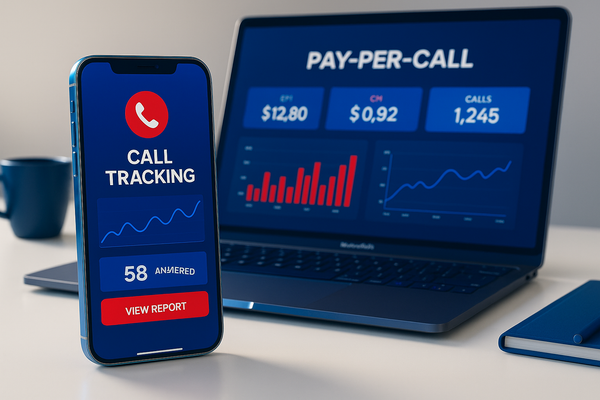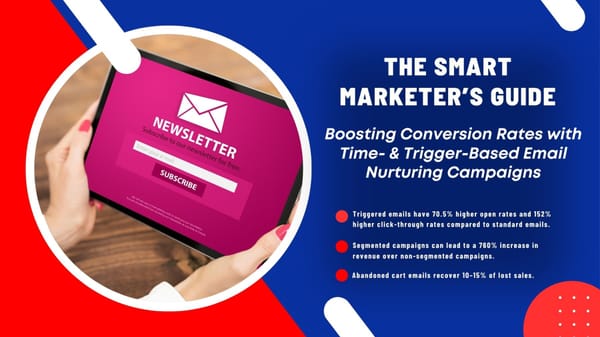Driving Success: Expert Insights on Driving Traffic in Affiliate Marketing

The internet is teeming with billions of users, interacting, communicating, searching, buying, and selling on a daily basis. In this bustling digital marketplace, affiliate marketing has emerged as a powerful way to turn clicks into cash. However, without a steady stream of traffic, your well-planned affiliate campaigns might remain unseen and underappreciated. The solution to this quandary is simple: to maximize your affiliate marketing earnings, you need to master the art of driving traffic to your campaigns.
Understanding Affiliate Marketing Traffic
Affiliate marketing revolves around a symbiotic relationship between advertisers, affiliates, and consumers. Affiliates promote a product or service by creating content and then linking to the advertiser's site. When consumers interact with these links and make purchases, affiliates earn a commission. Hence, the traffic — the volume and type of users visiting these links — is the lifeblood of successful affiliate marketing.
12 Stellar Affiliate Marketing Traffic Sources: Your Ultimate Guide to Skyrocketing Campaign Traffic
Affiliate marketing, with its dazzling potential for passive income, has surged into the spotlight in recent years. But let's face it – your efforts will crash and burn without a steady stream of traffic. Affiliate marketing is a unique beast in the world of online commerce, an elegant dance of persuasion that transforms passive viewers into active consumers. This art is accomplished through two critical steps: driving targeted traffic to your affiliate campaigns and inciting your audience to take action. So, how do you master these steps? Let's dive in with twelve actionable strategies.
1. SEO - From Visibility to Conversion
Search Engine Optimization (SEO) remains the reigning king of organic traffic sources. By optimizing your content with keywords, meta descriptions, and quality links, you can snag a high-ranking on-search engines, driving a steady flow of visitors to your site.
SEO is your first port of call, driving organic, targeted traffic to your website. But beyond optimizing for search engines, optimize for user experience. Improve your site's load speed, navigation, and mobile compatibility. A seamless user experience reduces bounce rates, thus increasing the chances of conversion.
It's a time-intensive process requiring patience and consistency. Utilize tools like SEMRush or Ahrefs for keyword research and competitor analysis. By understanding what your audience is searching for and how you stack up against competitors, you can build a robust, SEO-optimized content strategy.
2. PPC Advertising - Guaranteed Traffic at a Price
Pay-Per-Click (PPC) advertising, via platforms like Google Ads or Bing Ads, offers a surefire way to drive targeted traffic to your site. You bid on keywords relevant to your affiliate products, and your ad surfaces when users search those terms.
Pay-Per-Click (PPC) advertising guarantees visibility for your affiliate products. Optimize your ad copy to not just attract clicks, but to inspire action. Use compelling CTAs, create urgency, and highlight the benefits of the product. A well-optimized PPC ad can catapult your conversion rates.
PPC requires a budget but remember - you're investing in highly targeted visibility. Regularly track your campaigns, optimizing your bids and ad copy based on performance data, to ensure your ROI stays positive.
Connect with Brands to Create Genuine & Inspiring Content
Interested in learning how marketers optimize sales and revenue with the Bloomclicks Partnership? Bloomclicks is not just another partnership platform. It's a community of elite marketers who are passionate about transforming their financial futures and helping businesses grow.
JOIN OUR COMMUNITY3. Social Media - Unleashing the Power of Virality
Harness the viral potential of social media to promote your affiliate products. Use platforms like Facebook, Instagram, or TikTok, where your audience hangs out. Craft engaging, value-packed content about your affiliate products. And don’t forget to utilize platform-specific features like Facebook Groups or Instagram Stories.
Your social media strategy should be a balance of promotional and value-added content. Engage your audience with relatable stories, behind-the-scenes peeks, and user-generated content. The goal is to create a relationship with your followers, and when trust is established, they'll be more likely to act on your affiliate promotions.
Engage consistently with your audience, building a community around your brand. With enough momentum, your followers will become your marketers, sharing your content and driving traffic to your site.
4. Email Marketing: Personalization for Higher Conversion
Email marketing, while seemingly old-fashioned, boasts one of the highest ROIs in digital marketing. Grow an email list through lead magnets, newsletters, or gated content on your site.
Personalization is key in email marketing. Use your subscribers' names, acknowledge their past behavior, and send them tailored recommendations. A personalized email is a powerful tool, significantly improving click-through rates and conversions.
Segment your list to tailor your messaging to different user needs and preferences. Regularly nurture your subscribers with valuable content and exclusive offers, turning them into a reliable traffic source for your affiliate campaigns.
5. Content Marketing - Value that Compels Action
Content marketing involves creating valuable content to attract, engage, and convert your audience. Blogs, eBooks, webinars, or podcasts can all serve as vehicles for your affiliate links.
Your content should solve problems for your audience and position your affiliate products as the solution. Use persuasive writing techniques, such as scarcity ("Limited stock!") or social proof (testimonials), to nudge your audience towards purchasing.
The key is to provide real value - the kind that solves problems for your audience. With quality content, you'll establish yourself as a trusted expert, making your affiliate product recommendations much more compelling.
6. Influencer Marketing - Leverage Authority and Reach that Translates into Sales
Influencers have the power to sway their followers' buying decisions, by partnering with influencers in your niche, you can tap into their established authority and reach. They can introduce your affiliate products to their loyal audience, driving targeted traffic to your site.
Select influencers who align with your brand values and resonate with your target audience. Craft a mutually beneficial agreement that could involve commissions, fixed payments, or barter arrangements. A strong influencer endorsement can create a rush of traffic and conversions.
7. Online Forums and Communities - A Goldmine of Engaged Users
Online forums and communities like Quora or Reddit are a goldmine of engaged, curious users. By participating in relevant discussions and subtly promoting your affiliate products, you can attract highly interested traffic.
Your goal here is not just to drive traffic but to position yourself as a helpful expert. Answer questions, share insights, and subtly reference your affiliate products as solutions. Over time, this trust and authority can lead to a surge in traffic and conversions.
Avoid blatant self-promotion; instead, focus on adding value to the discussion. With a reputation for insightful, helpful contributions, users will be more inclined to visit your site and explore your recommendations.
8. Guest Blogging - Exposure that Engages
Guest blogging involves writing valuable posts for other blogs in your niche. In return, you gain backlinks and exposure to a new audience.
Guest blogging grants you exposure to a wider audience. The trick here is to write gripping content that entices readers to click through to your site. Use persuasive CTAs in your author bio and within the content, where appropriate, to guide readers towards your affiliate campaigns.
Select blogs with high domain authority and a relevant audience. Craft your guest posts with the same dedication as your own blog posts - remember, this is your chance to impress a whole new set of readers.
9. YouTube Marketing - Captivating Audiences with Video
YouTube is the second-largest search engine in the world, making it an excellent platform for your affiliate campaigns.
YouTube's massive audience presents a unique opportunity for affiliate marketers. Create engaging video content that solves problems for your audience, using your affiliate products as the solution. Use persuasive CTAs in your video or the description to lead viewers towards purchasing.
Optimize your videos for SEO, and don't forget to add your affiliate links in the video descriptions. With captivating video content, you can pull in a steady stream of traffic to your affiliate campaigns.
10. Webinars - Harness the Power of Education
Webinars can be a fantastic source of traffic for your affiliate campaigns. They offer an opportunity to educate your audience about your affiliate products in-depth, all while establishing your authority in your niche.
Structure your webinar to first provide immense value, then pitch your affiliate product as a logical next step. An effective webinar can generate a flood of conversions.
Promote your webinars extensively through your email list, social media channels, and partner networks. By providing immense value in your webinars, you'll leave your audience eager to explore your affiliate products.
11. Solo Ads - Buy Your Way into Subscriber Lists
Solo ads involve paying other businesses to promote your affiliate products to their email list. It's a quick way to reach a large, targeted audience. It's not just about getting the clicks - it's about inspiring action.
Choose partners with a relevant, engaged email list. Write a persuasive email copy that highlights the benefits of the product and uses a strong CTA to inspire action. Remember, you're borrowing your partner's trust with their audience - respect that by offering genuine value.
12. Retargeting - Re-engage the Lost Visitors
Retargeting involves marketing to users who have visited your site but didn't convert. By utilizing tracking cookies, platforms like Google Ads or Facebook Ads allow you to show specific ads to this audience.
Retargeting campaigns can re-engage lost visitors, nudging them back to your site. It's a powerful strategy that turns bounced traffic into potential sales.
Retargeting is your second chance to convert visitors who didn't purchase on their first visit. Tailor your retargeting ads based on the user's behavior on your site. Did they abandon their cart? Offer a small discount. Did they browse a particular product category? Show them related products. A well-structured retargeting campaign can significantly boost conversions.

Monitoring and Adjusting: The Secret Sauce for Affiliate Marketing Success
With the world of affiliate marketing at your fingertips, one principle stands tall: Success lies in your ability to monitor and adjust your traffic generation efforts. It's all about staying nimble, learning from your results, and continually fine-tuning your approach. If a strategy isn't working as expected, don’t be afraid to adjust or abandon it. Test new approaches and always stay on top of current trends and changes in the digital marketing landscape. Remember, flexibility and adaptability are key in the ever-evolving world of affiliate marketing. But how does this look in practice? Let's explore.
1. Set Your Metrics
Start by defining the key metrics you will use to measure your traffic generation efforts. These might include traffic volume, sources, bounce rate, time spent on page, and conversion rate. Keep your metrics actionable; they should directly inform the adjustments you make.
2. Utilize Analytics Tools
Web analytics tools are the backbone of your monitoring efforts. Google Analytics is a powerful, free tool that offers in-depth insights into your website traffic and user behavior. Social media platforms also provide native analytics tools, offering insights into post reach, engagement, follower growth, and more.
3. Regular Check-ins
Implement regular check-ins to analyze your data. Whether it's weekly, bi-weekly, or monthly, consistency is key. Regular reviews will help you spot trends, identify successful strategies, and detect any sudden changes in performance.
4. Dig Deeper with A/B Testing
A/B testing involves changing one variable at a time (such as a headline or CTA) to see which version performs better. This method can provide valuable insights into what resonates with your audience, helping you refine your content, design, and marketing strategies.
5. Learn from Your Successes and Failures
Identify your top-performing content and marketing strategies. What do they have in common? Is it the type of content, the promotional strategy, or the product itself? By understanding what works, you can replicate and scale your successes.
Likewise, don't shy away from your failures. They are just as informative, showing you what doesn't resonate with your audience. Use these insights to steer clear of ineffective strategies.
6. Adjust Based on Insights
Use your insights to fine-tune your traffic generation efforts. If certain content types or topics are driving the most traffic, produce more of that content. If a particular marketing strategy is underperforming, experiment with new approaches.
7. Keep Up with Industry Trends
Stay updated with industry trends and algorithm updates. These external factors can dramatically impact your traffic, and by staying in the loop, you can adjust your strategies proactively.
8. Be Patient
Remember that results may take time. SEO improvements, for instance, can take months to show results. Don't rush to change strategies if you don't see immediate results. Patience and consistency are crucial.
9. Regularly Update Your SEO
Search engines continuously update their algorithms, so your SEO strategy should be a living, evolving entity. Regularly revisit your keyword strategy, update meta descriptions, and optimize new content.
10. Keep Your Audience's Evolving Needs in Mind
Your audience's needs and interests will evolve over time. Monitor changes in user behavior and feedback, adjusting your content and marketing strategies to match their changing needs.

By monitoring and adjusting your traffic generation efforts, you turn your affiliate marketing strategy into a responsive, results-driven machine. It's all about learning, iterating, and growing. With this approach, you'll ensure your affiliate marketing efforts continue to thrive, no matter what changes come your way.
The key is to not get overwhelmed by trying to implement everything at once. Instead, select a few strategies that resonate most with your brand, and go all in on them. Remember, driving traffic to your affiliate campaigns is only half the battle - converting that traffic into sales is the other half.
In conclusion, generating traffic to your affiliate campaigns requires a blend of creativity, strategic planning, and ongoing monitoring. It's not an overnight process but a long-term commitment. When done right, the payoff can be immensely rewarding, offering you a stream of passive income and the opportunity to connect with audiences from all over the globe. So roll up your sleeves, tap into these strategies with consistent effort and optimization, your affiliate campaigns will be unstoppable. Happy marketing!





